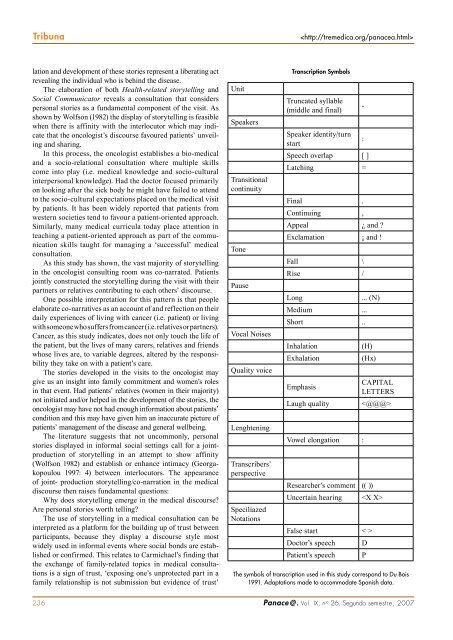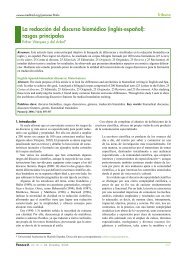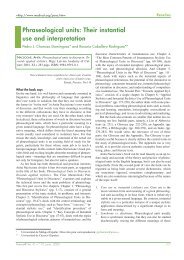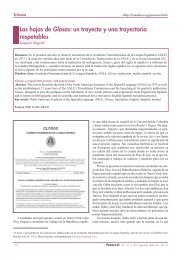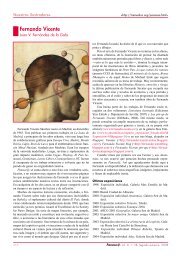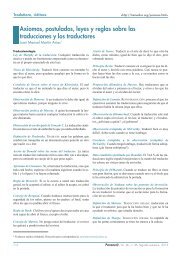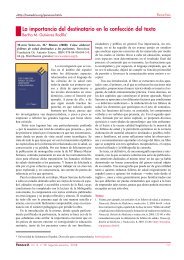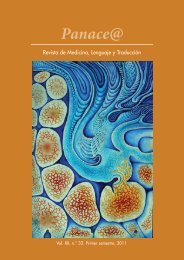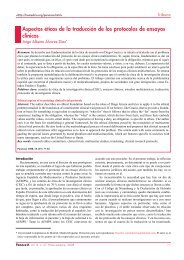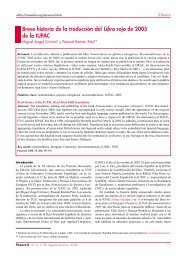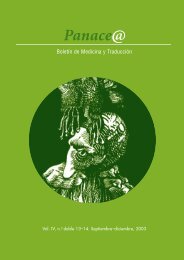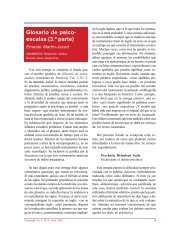Panace@ 26. Diciembre del 2007 - Tremédica
Panace@ 26. Diciembre del 2007 - Tremédica
Panace@ 26. Diciembre del 2007 - Tremédica
Create successful ePaper yourself
Turn your PDF publications into a flip-book with our unique Google optimized e-Paper software.
Tribuna<br />
<br />
lation and development of these stories represent a liberating act<br />
revealing the individual who is behind the disease.<br />
The elaboration of both Health-related storytelling and<br />
Social Communicator reveals a consultation that considers<br />
personal stories as a fundamental component of the visit. As<br />
shown by Wolfson (1982) the display of storytelling is feasible<br />
when there is affinity with the interlocutor which may indicate<br />
that the oncologist’s discourse favoured patients’ unveiling<br />
and sharing.<br />
In this process, the oncologist establishes a bio-medical<br />
and a socio-relational consultation where multiple skills<br />
come into play (i.e. medical knowledge and socio-cultural<br />
interpersonal knowledge). Had the doctor focused primarily<br />
on looking after the sick body he might have failed to attend<br />
to the socio-cultural expectations placed on the medical visit<br />
by patients. It has been wi<strong>del</strong>y reported that patients from<br />
western societies tend to favour a patient-oriented approach.<br />
Similarly, many medical curricula today place attention in<br />
teaching a patient-oriented approach as part of the communication<br />
skills taught for managing a ‘successful’ medical<br />
consultation.<br />
As this study has shown, the vast majority of storytelling<br />
in the oncologist consulting room was co-narrated. Patients<br />
jointly constructed the storytelling during the visit with their<br />
partners or relatives contributing to each others’ discourse.<br />
One possible interpretation for this pattern is that people<br />
elaborate co-narratives as an account of and reflection on their<br />
daily experiences of living with cancer (i.e. patient) or living<br />
with someone who suffers from cancer (i.e. relatives or partners).<br />
Cancer, as this study indicates, does not only touch the life of<br />
the patient, but the lives of many carers, relatives and friends<br />
whose lives are, to variable degrees, altered by the responsibility<br />
they take on with a patient’s care.<br />
The stories developed in the visits to the oncologist may<br />
give us an insight into family commitment and women’s roles<br />
in that event. Had patients’ relatives (women in their majority)<br />
not initiated and/or helped in the development of the stories, the<br />
oncologist may have not had enough information about patients’<br />
condition and this may have given him an inaccurate picture of<br />
patients’ management of the disease and general wellbeing.<br />
The literature suggests that not uncommonly, personal<br />
stories displayed in informal social settings call for a jointproduction<br />
of storytelling in an attempt to show affinity<br />
(Wolfson 1982) and establish or enhance intimacy (Georgakopoulou<br />
1997: 4) between interlocutors. The appearance<br />
of joint- production storytelling/co-narration in the medical<br />
discourse then raises fundamental questions:<br />
Why does storytelling emerge in the medical discourse?<br />
Are personal stories worth telling?<br />
The use of storytelling in a medical consultation can be<br />
interpreted as a platform for the building up of trust between<br />
participants, because they display a discourse style most<br />
wi<strong>del</strong>y used in informal events where social bonds are established<br />
or confirmed. This relates to Carmichael’s finding that<br />
the exchange of family-related topics in medical consultations<br />
is a sign of trust, ‘exposing one’s unprotected part in a<br />
family relationship is not submission but evidence of trust’<br />
Unit<br />
Speakers<br />
Transitional<br />
continuity<br />
Tone<br />
Pause<br />
Vocal Noises<br />
Quality voice<br />
Lenghtening<br />
Transcribers’<br />
perspective<br />
Speciliazed<br />
Notations<br />
Transcription Symbols<br />
Truncated syllable<br />
(middle and final)<br />
Speaker identity/turn<br />
start<br />
Speech overlap [ ]<br />
Latching =<br />
Final .<br />
Continuing ,<br />
Appeal ¿ and ?<br />
Exclamation ¡ and !<br />
Fall \<br />
Rise /<br />
Long<br />
Medium ...<br />
Short ..<br />
Inhalation<br />
Exhalation<br />
Emphasis<br />
Laugh quality<br />
Vowel elongation :<br />
-<br />
:<br />
... (N)<br />
(H)<br />
(Hx)<br />
Researcher’s comment (( ))<br />
CAPITAL<br />
LETTERS<br />
<br />
Uncertain hearing <br />
False start < ><br />
Doctor’s speech<br />
Patient’s speech<br />
The symbols of transcription used in this study correspond to Du Bois<br />
1991. Adaptations made to accommodate Spanish data.<br />
D<br />
P<br />
236 <strong>Panace@</strong>. Vol. IX, n .o <strong>26.</strong> Segundo semestre, <strong>2007</strong>


